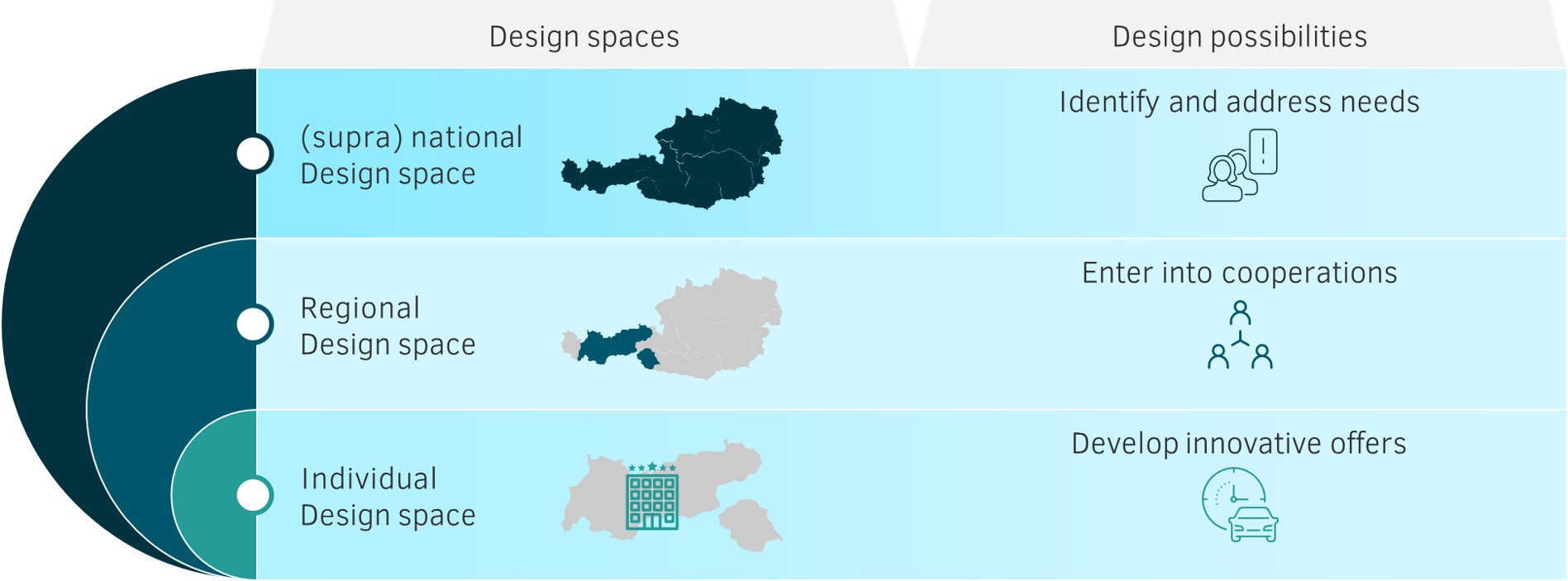The relationship between the further development of infrastructure and changing mobility needs and styles forms a complex cross-cutting issue for the attractiveness of a tourism location. Vacationers increasingly consider mobility options along the tourism travel chain – i.e. to, at and from the vacation destination – as part of the vacation offer[1]. Due to a lack of cooperation between tourism providers and transport service providers, consistently bookable multimodal mobility offers are currently scarce. A look at the means of transport chosen by Austrian holidaymakers reveals the need for action: according to a T-Mona study, 83% of holidaymakers travel to Austrian vacation destinations by car[2]. This technical article describes and calculates decarbonization potentials based on 3 scenarios along the tourism travel chain. In scenario 1, vacationers travel from Bavaria to Tyrol by e-car; in scenario 2, they exclusively use public transport to get to a Tyrolean tourist destination; and in scenario 3, alternative mobility options are used on site instead of the car. All in all, it can be seen that there is a high potential for CO2 savings especially in local mobility.
This article first highlights the status quo of tourism mobility in Austria, including challenges and potentials as well as best practices for alternative mobility to the car along the tourism travel chain.
The central challenges are the change of behavior of vacation guests (choice of means of transport), as well as the current lack of cooperation between tourism service providers and transport service providers to ensure a sustainable mobility guarantee along the tourism travel chain. In addition, topographical and geographical conditions bring different challenges.

Vacationers are increasingly considering consistent and sustainable mobility options as an important factor in their vacation decision. Tourism has the opportunity to take advantage of the trend toward sustainability and environmental awareness and to position itself accordingly. In addition, digitalization offers the potential to develop new services in response to the new mobility habits of vacationers from cities (e.g., mobility as a service, decreasing car ownership).
In general, there are three levers on how CO2 can be reduced in mobility: CO2-free vehicle propulsion (electromobility); increasing the occupancy rate (public transport); and reducing the distances traveled (city of short distances)[3]. In this technical article, the CO2 reduction potentials of the first two levers are calculated.
To classify the design options for measures to decarbonize tourist mobility along the travel chain, it is useful to divide them into three areas:

Described in more detail in the technical article, a scenario with a measure for reducing CO2 along the tourism travel chain was described and calculated for each of these three design areas:
Scenario 1: CO2-reduction in the individual design space by increasing electric kilometers.
- Measure: Cooperating accommodation establishments issue 1,000 vouchers (1 night á 2 persons). The condition is the arrival with the E-car.
- Lever: CO2-free vehicle drives.
Scenario 2: CO2-reduction in the supra-regional design area by increasing the occupancy rate.
- Measure: The city of Innsbruck is positioning itself as a mobility hub for guests arriving from the Munich/Bavaria area. Guests travel on to the tourist destination by shuttle bus.
- Lever: Increase of the occupation level.
Scenario 3: CO2–reduction in the regional design area by increasing the occupation level.
- Measure: A Tyrolean tourism destination coordinates and bundles multimodal mobility offers within the region in order to reduce travel by car.
- Lever: Increase of the occupation level.
In summary, it can be seen that it is above all a bundle of different measures that achieve a great effect. Local mobility sometimes shows very great savings potential. As a first step, service providers and tourism associations should analyze decarbonization potentials and address specific target groups of foreign source markets in geographic proximity. The key success factors for decarbonization strategies in tourism mobility include cooperation and interdisciplinary collaboration.
By creating joint services and digital platforms in the region, offerings can be bundled. Interdisciplinary collaboration promotes innovative strength within the region.
Quellen:
[1] Bundesministerium für Wirtschaft, Familie und Jugend (2013) – Studie Tourismusmobilität 2030 in Österreich -https://www.wko.at/branchen/tourismus-freizeitwirtschaft/Studie_Tourismusmobilitaet_2030_in_Oesterreich.html
[2] Bundesministerium für Landwirtschaft, Regionen und Tourismus (2021) – Tourismus Österreich 2020 – https://info.bmlrt.gv.at/dam/jcr:14cd00a1-2ae0-41ef-ba13-cb171710357b/Tourismusbericht%202020_bf.pdf
[3] accilium (2022) – Dekarbonisierung der Mobilität – https://accilium.com/de/dekarbonisierung-der-mobilitat-mit-welchen-hebeln-europa-die-lucken-in-der-klimazielerreichung-verringern-kann/

 ISO/IEC 27001:2013 certified
ISO/IEC 27001:2013 certified